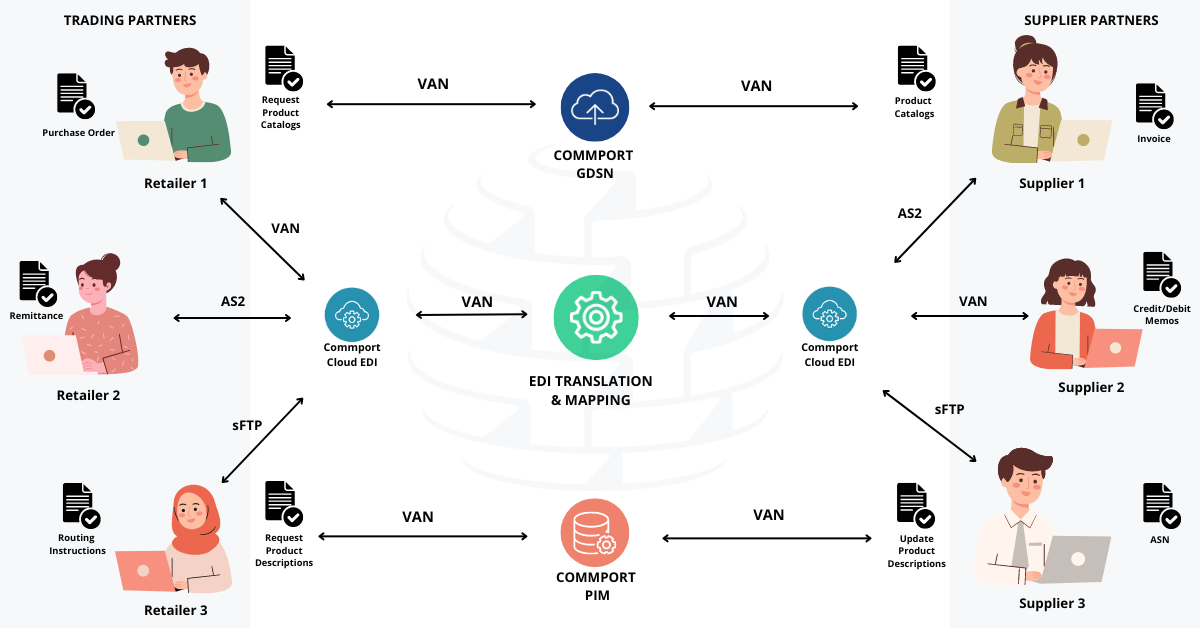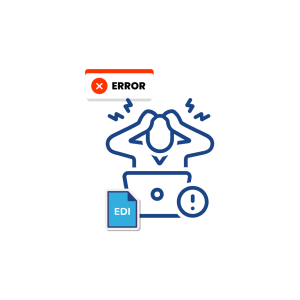Introduction
What is B2B Integration?
B2B integration, or business-to-business integration, refers to the process of connecting and integrating the systems, processes, and data of two or more organizations to enable seamless communication and collaboration. It involves the exchange of information, such as transactions, documents, and data, between businesses electronically, eliminating the need for manual intervention and paper-based processes.
B2B integrations facilitate businesses to automate and streamline various business processes, including procurement, order management, inventory management, logistics, and financial transactions. Some of the common B2B business transaction documents that are exchanged are purchase orders, invoices, inventory data, and more.
Successful and standardized B2B integration can be achieved through various methods, including electronic data interchange (EDI), value-added network (VAN), GDSN, PIM solution, application programming interfaces (APIs), specialized integrations, and other modern integration technologies
Key Takeaways
- B2B Integration connects business systems to streamline communication, data exchange, and collaboration with trading partners.
- It enhances efficiency by automating processes like ordering, invoicing, and inventory management.
- Integrated B2B systems improve data accuracy, reduce manual work, and ensure compliance with partner requirements.
- Effective B2B integration supports scalability, allowing businesses to adapt and grow with market demands.
- This approach boosts supply chain visibility and strengthens partnerships through seamless, real-time data sharing.

How do B2B Integrations Help Businesses Communicate?
The goal of B2B integration is to establish a standardized and reliable framework for exchanging information and conducting transactions between trading partners.
By implementing B2B integration solutions, businesses can achieve the following:
- Seamless information exchange
- Increased efficiency and productivity
- Enhanced collaboration
- Cost reduction
- Improved customer satisfaction
1. Seamless Information Exchange
B2B integration enables businesses to exchange data with their trading partners in a seamless and standardized manner. By automating the transfer of information, such as orders, shipments, and payments, companies can eliminate manual data entry, reduce errors, and accelerate the flow of critical information across the supply chain.
2. Increased Efficiency and Productivity
Manual and paper-based processes are time-consuming and prone to errors. B2B integration automates repetitive tasks, enabling businesses to improve efficiency and productivity. By eliminating manual data entry, companies can focus on more value-added activities, such as strategic decision-making and customer service.
3. Enhanced Collaboration
B2B integrations promotes collaboration between businesses by providing real-time access to shared data. This allows partners to synchronize their processes, optimize inventory levels, and align their operations more effectively. Collaborative B2B integration facilitates seamless coordination and visibility, leading to better decision-making and stronger partnerships.
4. Cost Reduction
By automating processes and reducing manual intervention, B2B integrations help companies cut costs associated with paper-based transactions, data entry errors, and inefficient workflows. It also minimizes the need for manual interventions, such as phone calls and emails, resulting in significant time and cost savings.
5. Improved Customer Satisfaction
B2B integrations enables businesses to respond quickly to customer demands. Real-time data exchange helps ensure accurate order processing, faster order fulfillment, and improved customer service. The ability to provide accurate, timely information to customers enhances satisfaction and strengthens business relationships.
Importance of EDI, VAN, GDSN, and PIM in B2B Integrations

1. Electronic Data Interchange (EDI)
EDI is a key component of B2B integration, enabling the structured and standardized exchange of business documents between trading partners. It eliminates the need for paper-based processes, such as faxing or mailing, and replaces them with electronic transmission, resulting in faster, more accurate, and more efficient data exchange.
EDI offers several benefits in B2B integration
- Standardization: EDI relies on standardized formats, such as EDIFACT or ANSI X12, ensuring consistent data representation across different systems. This simplifies the integration process and reduces compatibility issues between trading partners.
- Automation: With EDI, businesses can automate the exchange of EDI documents, including purchase orders, invoices, shipping notices, and more. This automation reduces manual errors, speeds up transaction processing, and improves overall operational efficiency.
- Scalability: EDI is highly scalable, allowing businesses to handle a large volume of transactions without compromising performance. It accommodates the growth of trading partner networks and supports increased collaboration and data exchange.
Download: EDI Buyers Guide
Unlock the full potential of your supply chain with our comprehensive EDI Buyer's Guide — your first step towards seamless, efficient, and error-free transactions

2. Value-Added Networks
VAN acts as an intermediary in B2B integration, providing a secure and reliable platform for transmitting EDI documents between trading partners. VANs offer additional services that enhance the efficiency and security of B2B communications.
Key advantages of VAN in B2B integration include
- Security: VANs employ robust security measures, such as encryption and data backups, to protect sensitive business information during transmission. They also offer non-repudiation services, ensuring that each party involved in the communication cannot deny their participation.
- Message Tracking and Monitoring: VANs provide tracking and monitoring capabilities, allowing businesses to track the status of their transactions and identify any issues or delays. This real-time visibility helps improve operational efficiency and reduces the risk of errors or disruptions.
- Partner Connectivity: VANs simplify the onboarding process for new trading partners by offering a centralized network. This enables businesses to quickly establish connections, exchange data, and collaborate with a wide range of partners, regardless of their technical capabilities.
Download: VAN Buyers Guide
Maximize your business efficiency with the right VAN provider! Grab your free VAN Buyer's Guide and discover the key features and services that will elevate your EDI transactions to the next level.
Make an informed decision today!

3. Global Data Synchronization Network (GDSN)
GDSN is a network-based data pool that enables real-time synchronization of product data among trading partners. It ensures that all participants have access to accurate and up-to-date product information, such as descriptions, attributes, pricing, and packaging details.
GDSN offers several benefits in B2B integration
- Improved Data Accuracy and Consistency: By synchronizing product data across the supply chain, GDSN eliminates discrepancies and inaccuracies caused by manual data entry or outdated information. This leads to better decision-making, reduced errors, and improved customer satisfaction.
- Enhanced Supply Chain Efficiency: GDSN enables seamless information exchange between suppliers, retailers, and distributors, resulting in better inventory management, faster product launches, and improved demand forecasting. It streamlines processes and reduces time-to-market for new products.
- Regulatory Compliance: GDSN supports compliance with industry regulations and standards, such as GS1. By providing accurate and standardized product information, it helps businesses meet labeling, traceability, and safety requirements imposed by regulatory bodies.
Download: GDSN Buyers Guide
Empower your business with global data synchronization; download our GDSN Buyer's Guide today and take the first step towards streamlined, accurate, and compliant product data management.

4. PIM Solution
A Product Information Management solution plays a vital role in today’s digital landscape, especially for businesses dealing with a wide range of products.
Here are some key reasons highlighting its importance
- Centralized Product Data Management: PIM solutions provide a centralized platform for managing all product-related information. This includes product descriptions, specifications, images, pricing, and other crucial details. Having a single source of truth ensures consistency and accuracy across various channels and systems.
- Improved Data Quality: With PIM, businesses can ensure data integrity by standardizing product information according to predefined rules and formats. This helps in reducing errors, inconsistencies, and duplication of data, leading to higher data quality.
- Enhanced Product Experience: Consistent and accurate product information is essential for providing a seamless and enriched customer experience. PIM enables businesses to deliver relevant and up-to-date product content across multiple touchpoints, including websites, mobile apps, marketplaces, and printed materials.
- Time and Cost Efficiency: By streamlining the process of managing product information, PIM solutions help save time and reduce operational costs. Automated workflows, bulk editing capabilities, and integration with other business systems improve efficiency and productivity.
- Support for Omnichannel Commerce: In today’s omnichannel retail environment, customers expect a unified shopping experience across various channels. PIM enables businesses to syndicate product data to different sales channels, including e-commerce platforms, brick-and-mortar stores, social media, and more, ensuring consistency and coherence in product presentation.
- Facilitates Global Expansion: For businesses operating in multiple regions or targeting international markets, PIM solutions help in managing product information in multiple languages and adapting content to local market requirements. This enables smooth expansion into new territories while maintaining brand consistency.
- Data Analytics and Insights: PIM solutions often come with built-in analytics capabilities that provide valuable insights into product performance, customer behavior, and market trends. By analyzing this data, businesses can make informed decisions regarding product assortment, pricing strategies, and marketing campaigns.
- Compliance and Regulation Management: Many industries have stringent regulations regarding product information and labeling. PIM solutions can help businesses ensure compliance with industry standards, regulatory requirements, and labeling guidelines, thereby mitigating the risk of non-compliance and potential penalties.
Conclusion
B2B integration is a fundamental aspect of modern business operations, allowing organizations to collaborate effectively, automate processes, streamline information exchange, and enhance overall efficiency. By implementing B2B integration solutions, businesses can improve their competitiveness, strengthen partnerships, and adapt to the evolving demands of the digital economy.
Explore Commport B2B Integration Solutions
Frequently Asked Questions
B2B integration solutions employ robust security measures, including encryption, authentication, and data integrity checks, to ensure the confidentiality and integrity of exchanged data. Compliance with industry standards, such as PCI DSS and GDPR, further enhances security.
Absolutely! B2B integration is not limited to large enterprises. Small businesses can benefit from streamlined communication, improved efficiency, and reduced costs by integrating their systems with trading partners.
While the complexity of B2B integration varies depending on the specific requirements and systems involved, modern integration technologies have simplified the implementation process. Cloud-based integration platforms and pre-built connectors make it easier for businesses to connect with their partners.





